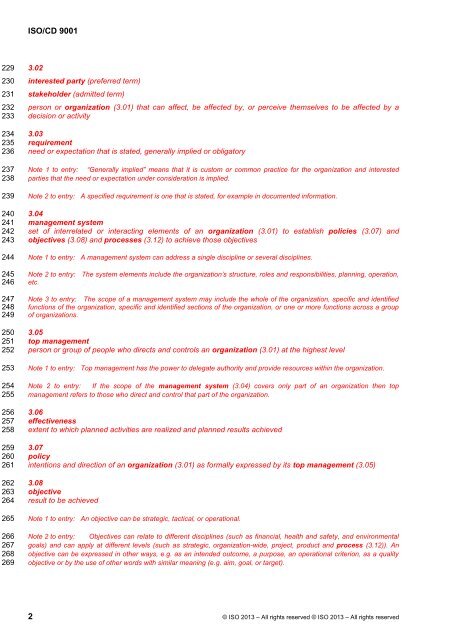borrador-iso-9001-2015
borrador-iso-9001-2015
borrador-iso-9001-2015
You also want an ePaper? Increase the reach of your titles
YUMPU automatically turns print PDFs into web optimized ePapers that Google loves.
ISO/CD <strong>9001</strong>2292302312322332342352362372382392402412422432442452462472482492502512522532542552562572582592602612622632642652662672682693.02interested party (preferred term)stakeholder (admitted term)person or organization (3.01) that can affect, be affected by, or perceive themselves to be affected by adecision or activity3.03requirementneed or expectation that is stated, generally implied or obligatoryNote 1 to entry: ―Generally implied‖ means that it is custom or common practice for the organization and interestedparties that the need or expectation under consideration is implied.Note 2 to entry: A specified requirement is one that is stated, for example in documented information.3.04management systemset of interrelated or interacting elements of an organization (3.01) to establish policies (3.07) andobjectives (3.08) and processes (3.12) to achieve those objectivesNote 1 to entry: A management system can address a single discipline or several disciplines.Note 2 to entry: The system elements include the organization‘s structure, roles and responsibilities, planning, operation,etc.Note 3 to entry: The scope of a management system may include the whole of the organization, specific and identifiedfunctions of the organization, specific and identified sections of the organization, or one or more functions across a groupof organizations.3.05top managementperson or group of people who directs and controls an organization (3.01) at the highest levelNote 1 to entry: Top management has the power to delegate authority and provide resources within the organization.Note 2 to entry: If the scope of the management system (3.04) covers only part of an organization then topmanagement refers to those who direct and control that part of the organization.3.06effectivenessextent to which planned activities are realized and planned results achieved3.07policyintentions and direction of an organization (3.01) as formally expressed by its top management (3.05)3.08objectiveresult to be achievedNote 1 to entry: An objective can be strategic, tactical, or operational.Note 2 to entry: Objectives can relate to different disciplines (such as financial, health and safety, and environmentalgoals) and can apply at different levels (such as strategic, organization-wide, project, product and process (3.12)). Anobjective can be expressed in other ways, e.g. as an intended outcome, a purpose, an operational criterion, as a qualityobjective or by the use of other words with similar meaning (e.g. aim, goal, or target).2 © ISO 2013 – All rights reserved © ISO 2013 – All rights reserved


